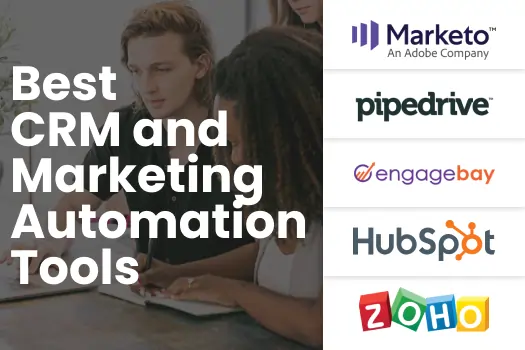B2B sales, or business-to-business sales, refer to transactions where one business sells products or services to another business rather than individual consumers.
Unlike B2C (business-to-consumer) sales, B2B sales often involve longer sales cycles, multiple decision-makers, and larger transaction values.
B2B e-commerce sales in the U.S. are expected to reach $3.1 billion by 2027, significantly surpassing B2C e-commerce revenue, which is projected to reach only $1.7 billion in the same period.
Successful B2B sales strategies require a mix of relationship-building, technology integration, and data-driven decision-making.
This blog will explore everything you need about B2B sales, from its definition to strategies, challenges, and best practices.
What Is B2B Sales?
B2B sales involve businesses selling to other businesses, often requiring a more consultative approach compared to B2C sales. These sales typically occur in manufacturing, software, healthcare, and professional services.
B2B sales are defined by higher transaction values, making each deal a significant investment for businesses. The sales cycles tend to be longer, often requiring extensive research, negotiations, and approvals before purchasing.
Unlike B2C sales, where individuals typically make decisions, B2B sales involve multiple decision-makers, including executives, procurement teams, and department heads. This process is highly relationship-driven, as trust and credibility are crucial in securing long-term partnerships.
Additionally, B2B buyers prioritize return on investment (ROI) and business impact, ensuring that every purchase aligns with their strategic goals and contributes to overall growth.
Types of B2B Sales
B2B sales can be broadly classified into three main types:
-
Product-based B2B Sales: Businesses sell physical or digital products to other businesses (e.g., office supplies, industrial equipment, SaaS products).
-
Service-based B2B Sales: Companies offer marketing, consulting, or IT solutions to other businesses.
-
Wholesale and Distribution Sales: Businesses sell goods in bulk to retailers or other companies.
But there’s more. Check out the table below.
| Type of B2B Sale | Description | Example |
|---|---|---|
| Product-Based B2B Sales | Businesses sell physical or digital products to other businesses. | A SaaS company selling cloud-based CRM software to enterprises. |
| Service-Based B2B Sales | Companies offer marketing, consulting, or IT solutions to other businesses. | A digital marketing agency providing SEO and PPC services to eCommerce brands. |
| Wholesale and Distribution Sales | Businesses sell products in bulk to retailers, resellers, or manufacturers. | A wholesaler supplying grocery items to supermarket chains. |
| Manufacturing Sales | Manufacturers sell raw materials, parts, or finished products to other businesses for further production or assembly. | A steel manufacturer supplying materials to an automobile company. |
| Enterprise Sales (Complex B2B Sales) | Large-scale, high-value deals involving multiple stakeholders, long sales cycles, and customized solutions. | An IT solutions provider closing a multi-million-dollar cybersecurity deal with a global bank. |
| Channel Sales (Partner or Reseller Sales) | Companies sell products or services through third-party partners, resellers, or distributors instead of directly to the end customer. | A cloud computing company partnering with resellers to distribute its solutions. |
| Account-Based Sales | A highly targeted B2B sales approach focused on selling to specific high-value accounts using personalized strategies. | A marketing automation company developing custom sales pitches for Fortune 500 companies. |
Looking to enhance your B2B sales strategy that leads to business transformation from within? Saffron Edge is a leader in marketing and lead generation and specializes in optimizing business processes from the core leading to sales and marketing alignment.
Contact us today to take your B2B sales to the next level!
Difference between B2B and B2C Sales
The key difference between B2B and B2C sales lies in their audience, sales approach, and decision-making process.
B2B sales involve longer cycles, multiple decision-makers, and high-value transactions, often requiring tailored solutions and strong relationship management.
In contrast, B2C sales are faster, emotion-driven, and focused on individual consumers. Branding, convenience, and price play a major role. While B2B relies on personalized marketing and negotiations, B2C thrives on mass marketing and quick purchasing decisions.
| Aspect | B2B Sales | B2C Sales |
|---|---|---|
| Target Audience | Businesses, organizations, or institutions. | Individual consumers or households. |
| Decision-Making | Involves multiple stakeholders (e.g., procurement, finance, executives). | Made by a single person or a small group (family, friends). |
| Sales Cycle | Longer sales cycles (weeks to months) due to complex approvals. | Shorter sales cycles (minutes to days) as decisions are quick. |
| Purchase Value | High-value transactions; purchases often involve large sums. | Low to moderate transaction value per purchase. |
| Relationship Focus | Long-term relationships and repeat business are crucial. | Transactional, often focused on one-time purchases. |
| Customization | Highly personalized solutions based on business needs. | Standardized products with little to no customization. |
| Marketing Approach | Relationship-driven; relies on direct sales, networking, and content marketing. | Mass marketing strategies such as advertising, promotions, and socia media. |
| Pricing Model | Negotiable pricing, often based on contracts or bulk purchasing. | Fixed pricing with discounts or seasonal offers. |
| Product Knowledge | Requires detailed product knowledge, demos, and technical support. | Simple product information is sufficient; emotional appeal is key. |
| Customer Expectations | Focus on ROI, efficiency, and long-term value. | Focus on convenience, price, and brand appeal. |
The B2B Sales Process
The B2B (business-to-business) sales process is a strategic and structured journey that sales teams follow to convert prospects into loyal customers.
It involves multiple stages designed to assess, nurture, and ultimately close a sale with a company or organization. Here's a detailed breakdown of each step:
Prospecting
Prospecting is the first and foundational stage of the B2B sales process. It involves identifying and targeting potential businesses or organizations that benefit from your products or services. These prospects can come from various sources:
-
Cold Calling: Reaching out directly to companies with no prior interest.
-
Social Media Marketing: Using LinkedIn, Twitter, or industry-specific forums to find potential leads.
-
Referrals: Leveraging existing customers or industry connections to get introductions to new prospects.
-
Inbound Marketing: Drawing prospects to your business through content marketing, SEO, and other strategies designed to attract interest.
At this stage, the goal is to create a list of companies that could potentially benefit from what your business offers.
Lead Qualification
Not all prospects are the right fit for your business. Lead qualification is the process of evaluating which prospects have the highest potential to become paying customers. Various frameworks are used to qualify leads, with one of the most common being BANT:
-
Budget: Does the prospect have the financial resources to purchase your product or service?
-
Authority: Is the person you're communicating with the decision-maker, or are they just influencers in the purchase decision?
-
Need: Does the prospect have a problem that your product or service can solve?
-
Timeline: What is the prospect’s timeframe for making a purchase decision?
By assessing these factors, you can prioritize leads that are more likely to convert into sales, saving time and resources.
Needs Assessment
Once you've qualified a lead, conducting a needs assessment is important to deeply understand their specific challenges, pain points, and requirements. This step typically involves:
-
Discovery Calls: These are initial meetings or calls where you ask open-ended questions to understand the lead’s current situation, challenges, and objectives.
-
Surveys or Questionnaires: Sometimes, you may use forms or surveys to gather more information about the lead’s needs.
-
Market Research: This can include understanding the industry, competitors, and trends that may affect the prospect.
During the needs assessment phase, the primary goal is to tailor your approach and solutions to align with the prospect’s unique needs.
Presentation and Proposal
Once you’ve fully understood the prospect’s needs, the next step is to present your solution. This is where you demonstrate how your product or service can solve the problems or meet the requirements discussed in the needs assessment. This stage can involve:
-
Product Demos: Show the prospect how your solution works in real-time, focusing on the features most relevant to their needs.
-
Customized Presentations: Tailoring your pitch to the specific challenges the prospect faces, often using data, case studies, or industry-specific examples to make a compelling argument.
-
Proposal Documents: A formal proposal that outlines the solution, pricing, terms, and other relevant details. Proposals should be clear, concise, and persuasive and address the prospect's pain points.
The presentation and proposal stage is about demonstrating the value and benefits of your solution in a way that resonates with the prospect.
Negotiation and Closing
The prospect has shown interest, but the deal isn’t closed yet. Negotiations begin as the prospect reviews the offer, and several factors are discussed:
-
Price: Pricing discussions are often central to negotiations, with the prospect potentially asking for discounts or better terms.
-
Contract Terms: The terms of the agreement, including payment schedules, delivery dates, and any other stipulations, are negotiated.
-
Additional Support Requirements: Some prospects may request extra services, such as training or customer support, which can be factored into the deal.
The goal during this stage is to reach an agreement that satisfies both parties and results in a signed contract.
Post-Sales Support
B2B sales don’t end once the deal is closed. Building long-term relationships with customers is crucial for repeat business and referrals. Post-sales support involves:
-
Onboarding: Ensuring the customer can successfully implement and use your product or service. This may involve training, setup assistance, or other services.
-
Customer Support: Providing ongoing help for any customer issues after the purchase.
-
Continuous Engagement: Maintaining regular communication to check customer satisfaction, gather feedback, and potentially upsell or cross-sell additional products or services in the future.
The post-sales stage is about ensuring customer satisfaction and cultivating a strong relationship that could lead to future business opportunities, including renewals or referrals.
Drive More B2B Sales with Data-Driven Digital Marketing
Saffron Edge helps businesses grow with expert B2B marketing, lead generation, and sales optimization. Boost conversions with SEO, PPC, and content marketing.
Challenges in B2B Sales
B2B sales can be complex and challenging due to various factors affecting decision-making. Let’s break down each of the challenges mentioned:
Long Sales Cycles
In B2B sales, buying often takes much longer than B2C (business-to-consumer) transactions. There are several reasons why B2B sales cycles are prolonged:
-
Multiple Stakeholders: In B2B, the decision-making process usually involves multiple stakeholders from different departments (e.g., finance, operations, procurement, etc.), each of whom may need to approve the purchase. This introduces a level of complexity that can delay decisions.
-
Approval Processes: There is a formal approval process for purchases in many businesses, especially large ones. This could include multiple rounds of reviews, budget considerations, and compliance checks, all of which slow down the sales cycle.
-
Research and Evaluation: B2B buyers typically conduct thorough research, compare vendors, and assess various options before deciding. They might also need to conduct a pilot program or gather feedback from different departments, which adds to the timeline.
The long sales cycle requires patience, a strategic approach to nurturing leads, and consistent follow-up throughout.
Multiple Decision-Makers
In B2B sales, purchasing decisions are rarely made by a single individual, as they often are in B2C sales. Instead, decisions are made by a group of people, which can complicate the process:
-
Decision Committees: A typical B2B purchase might involve a purchasing committee made up of individuals from various departments (e.g., IT, finance, marketing, and operations). Each of these stakeholders has different priorities and concerns.
-
Diverse Perspectives: While one person might be focused on the product's technical functionality, another may prioritize cost savings, and yet another may be concerned with its long-term strategic value; understanding these different perspectives and addressing them individually can be time-consuming.
-
Internal Politics: Organizations may also have internal politics that affect decision-making. Certain stakeholders might have personal preferences or biases towards certain vendors, which can delay the approval process or create barriers to closing the deal.
This requires the sales team to engage with multiple people within the organization, tailoring their message to each stakeholder’s needs and concerns. Effective communication and relationship-building with all involved is crucial.
High Competition
B2B sales often occur in crowded markets, with multiple competitors offering similar products or services. Standing out in such competitive landscapes can be challenging, especially when:
-
Similar Products and Services: Many businesses offer comparable solutions, and the differentiation often comes down to small features, pricing, or customer service.
-
Price Sensitivity: In some cases, price becomes a major differentiator, leading to a “race to the bottom” where companies lower their prices to win business, eroding profit margins.
-
Brand Loyalty: Some buyers may be highly loyal to existing suppliers or have long-standing relationships with vendors, making it harder for newcomers to enter the market.
To overcome competition, businesses must clearly articulate their unique value proposition (UVP), showcasing what sets them apart. This could involve offering superior customer service, additional features, specialized expertise, or a more flexible contract.
Evolving Buyer Expectations
In today’s digital-first world, B2B buyers have evolving expectations that are changing the traditional sales process:
-
Digital-First Experiences: Buyers now expect to be able to research products, request demos, and get pricing information online without having to speak to a sales representative. A strong online presence, with informative content such as white papers, case studies, and product videos, is crucial for attracting and engaging potential buyers.
-
Self-Service Options: More buyers prefer to explore options, make decisions, and even purchase without direct interaction with a salesperson. They want access to self-service tools like product configurators, pricing calculators, and online ordering platforms.
-
Personalized Buying Journeys: Buyers now expect personalized experiences. They want to receive content, offers, and product recommendations tailored to their industry, business size, and needs.
-
Social Proof and Reviews: B2B buyers increasingly rely on peer reviews, testimonials, and case studies to make decisions. They seek proof that similar businesses or industries have successfully used a product or service.
Sales strategies must adapt to this shift by embracing digital tools and providing a seamless, personalized experience. Relying solely on traditional sales methods such as cold calls, in-person meetings, or generic product pitches may no longer be effective.
Strategies for Successful B2B Sales
To overcome challenges and drive revenue growth, businesses must implement effective sales strategies. Here are some key approaches:
Leverage Digital Sales Channels
The modern B2B buyer conducts extensive online research before engaging with a sales rep. Utilize digital marketing, Search Engine Optimization, and social selling on platforms like LinkedIn to attract prospects.
Use Account-Based Selling (ABS)
Rather than targeting a broad audience, focus on high-value accounts that fit your ideal customer profile (ICP) and customize outreach and marketing efforts for them.
Invest in Sales Enablement Tools
CRM software, automation tools and AI-driven analytics help sales teams track leads, personalize communication, and improve efficiency.
Focus on Consultative Selling
B2B buyers appreciate sales reps who act as consultants rather than just sellers. Understand their challenges and provide valuable insights rather than just pitching a product.
Nurture Relationships with Follow-Ups
Regular follow-ups and personalized communication help keep prospects engaged throughout the long sales cycle.
Best Practices for B2B Sales Teams
To succeed in sales, businesses must adopt strategies that enhance their approach to engaging prospects, closing deals, and driving long-term success.
Build Trust with Prospects
In B2B sales, trust is a crucial factor in decision-making. Since purchases often involve significant investments and long-term commitments, businesses need assurance that they choose the right vendor or service provider.
-
Be Transparent: Communicate pricing, contract terms, and any limitations of your product or service. Avoid misleading claims or hidden costs.
-
Show Credibility: Use case studies, testimonials, and success stories to demonstrate how other businesses have benefited from your solution.
-
Consistent Communication: Keep prospects informed throughout the sales process, providing honest and timely responses to their inquiries.
-
Deliver on Promises: If you commit to a follow-up, proposal, or demo, ensure it is delivered as expected. Unreliable interactions erode trust quickly.
Develop a Value Proposition
A strong value proposition sets your business apart from competitors and directly addresses the customer's pain points. Without a compelling value proposition, prospects may struggle to see why they should choose your product or service over others.
-
Identify Customer Pain Points: Understand the key challenges your target audience faces.
-
Position Your Solution as the Answer: Clearly articulate how your product or service resolves those challenges.
-
Highlight Unique Differentiators: Emphasize what makes your offering better than competitors, whether it’s superior features, better pricing, outstanding customer service, or faster implementation.
-
Keep it Clear and Concise: A strong value proposition should be short, impactful, and easy to understand.
Use Data to Drive Decisions
Sales strategies should be based on real customer insights and performance analytics, not just intuition. Data-driven decision-making helps businesses identify patterns, optimize efforts, and improve conversion rates.
-
Analyze Sales Analytics: Use CRM software to track lead conversion rates, sales cycles, and customer interactions to refine sales strategies.
-
Segment Target Customers: Analyze customer data (e.g., industry, company size, previous purchase behavior) to identify high-value prospects.
-
Predict Trends: Leverage historical data and AI-powered analytics to anticipate market shifts and customer needs.
-
Measure Performance: Continuously assess KPIs (key performance indicators) like response rates, deal closure rates, and revenue growth to optimize sales strategies.
Train Sales Reps Effectively
The sales landscape constantly evolves, with new tools, technologies, and customer expectations emerging regularly. Continuous training ensures sales reps stay competitive, confident, and skilled in closing deals.
-
Provide Ongoing Training: Regular workshops, sales boot camps, and e-learning modules help reps stay updated on industry trends.
-
Role-Playing and Simulations: Practicing real-world sales scenarios helps reps develop objection-handling skills.
-
Equip Them with the Right Tools: Ensure reps are familiar with CRM systems, data analytics platforms, and sales automation tools to optimize their workflow.
-
Encourage Peer Learning: Conduct knowledge-sharing sessions where top performers share their strategies with the team.
Collaborate with Marketing Teams
Sales and marketing alignment ensures a consistent and effective lead-generation process. Businesses may face inefficient communication, missed opportunities, and inconsistent messaging if these teams work in isolation.
-
Define a Clear Lead Qualification Process: Ensure marketing teams pass high-quality leads to sales reps rather than unqualified prospects.
-
Use Shared Data and Insights: Marketing teams should share customer behavior insights and campaign analytics with sales to refine targeting strategies.
-
Align Messaging and Content: Ensure that the marketing content (e.g., blogs, case studies, email campaigns) supports the sales process by addressing common customer concerns.
-
Regular Meetings and Feedback Loops: Conduct weekly or monthly sync-up meetings between sales and marketing teams to review performance and adjust strategies.
Conclusion
By adopting best practices and staying ahead of industry trends, your business can thrive in the ever-evolving world of B2B sales.
At Saffron Edge, we help businesses implement cutting-edge sales automation strategies that streamline lead generation, nurture prospects, and maximize revenue. Ready to supercharge your B2B sales?
Let’s build a high-performance sales engine tailored to your business needs—connect with us today!
Get The Ultimate Marketing Toolkit
Frequently Asked Questions
What is B2B sales?
B2B sales, or business-to-business sales, involve transactions where one business sells products or services to another business. These sales typically have longer cycles, involve multiple decision-makers, and focus on providing value and ROI to the buyer.
How is B2B sales different from B2C sales?
B2B sales target businesses rather than individual consumers, requiring a consultative approach, relationship-building, and a longer sales cycle. B2C sales, on the other hand, are often transactional and focus on immediate customer needs.
What are the main challenges in B2B sales?
B2B sales face challenges such as long decision-making cycles, multiple stakeholders, high competition, and evolving buyer expectations. To stay ahead, businesses must adopt digital strategies and sales enablement tools.
What strategies can improve B2B sales success?
Effective B2B sales strategies include leveraging digital sales channels, adopting account-based selling, using CRM tools, focusing on consultative selling, and maintaining consistent follow-ups with prospects.
How can Saffron Edge help improve B2B sales?
Saffron Edge specializes in B2B digital marketing, lead generation, and sales optimization. With expert SEO, PPC, and content marketing strategies, we help businesses enhance brand visibility and drive high-quality leads. Contact us today to get started!
Related Blogs
We explore and publish the latest & most underrated content before it becomes a trend.
6 min read
Critical Gaps in eCommerce Marketplace Optimization That Is Hurting Your Sales
By Sabah Noor8 min read
10 Best CRM and Automation Tools: Streamline Your Business in 2024
By Praveen Kumar
Subscribe to Saffron Edge Newsletter!

Get The Ultimate Marketing Toolkit










